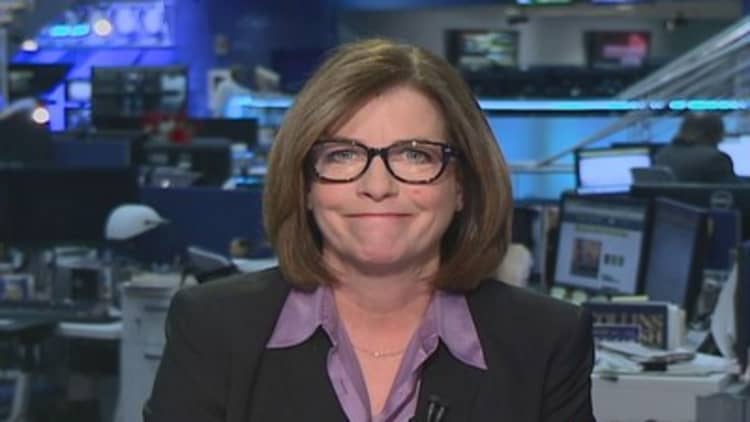
Selling in stocks and a surge of buying in bonds—driving interest rates dramatically lower—accelerated Thursday after negative reports on manufacturing and housing, two key legs of the economy.
But the positive momentum in the bond market was already in full swing and has been the trend this week around the globe as traders react to central bank easing, particularly in Europe. Thursday's rout also reverses a schism in markets, where bonds had been moving higher and stocks were also rising, with the Dow and at record highs earlier this week.
Markets were also spooked by comments from widely followed hedge fund manager David Tepper, who was cautious on stocks and said he was not recommending going short but "don't be too fricking long right now." That comment, in various iterations and spellings, sped around Wall Street overnight and greeted many traders in their in boxes Thursday morning.
Read MoreTepper: I think it's nervous time
The 10-year Treasury charted a parallel course to the German bund, which was yielding 1.30 percent. The 10-year yield broke below the psychological 2.50 percent, a level many analysts thought would hold as a floor just days ago. While positive for mortgage rates and other loans, the drop in bond yields has been worrying stock traders who fear it is signaling a weaker economy.
"I think it's a pain-laden short squeeze," said David Ader, chief Treasury strategist at CRT Capital.
Read More'Shell shock' bond move sends yields to pre-taper low
The conventional view on Wall Street had been that rates would rise this year as the Fed stepped back from its quantitative easing program and the economy improved. Instead, yields have fallen, forcing a huge short position to reverse.
Stocks, bristling from the swift drop in yields, fell sharply with selling largely in growth-related names and sectors. The Dow was down triple digits, while the S&P 500 fell more than 1 percent. The Nasdaq and Russell 2000 once more led the decline with the steepest losses in small cap, tech and biotech names.
Early morning economic data was strong with a drop in jobless claims to 297,000, the lowest in seven years. Meanwhile, Empire State data showed a big pickup in regional activity, and the Consumer Price Index rose as expected by 0.3 percent.
Read MoreClaims hit 7-year low as inflation rears its head
But the later reports told a mixed story, with a surprising 0.6 percent plunge in industrial production, its swiftest decline in more than 1½ years. The National Association of Home Builders sentiment falling to 45, turned negative and was the most pessimistic in a year. The Philadelphia Fed survey also moved slightly lower.
"The thesis of a better economy keeping the markets bid is being put to the test," said Julian Emanuel, U.S. equity and derivative strategist at UBS. "Our belief is the economy is going to come through, but we've been telling clients all year—when the market gets wobbly, we want to wait for a spike in the VIX to become buyers."
The VIX is the CBOE's volatility index, a fear gauge for stocks, and it was roaring ahead, up more than 10 percent to just above 13. Emanuel says it flashes buy to him as it approaches 20.
"All I can say as a person who has been trading the market to see what I saw yesterday and have the PPI come out hot as in more inflation ... and have the bonds rally the way they did, tells me something is not right with the markets," said Emanuel.
Stocks investors have been banking on an improvement in the economy to match the gains in the stock market and propel earnings growth. The first quarter data was distorted by bad weather and there was absolutely no growth in GDP, but hopes are still high for the second quarter to grow 3 percent or better.
Ader said the economic data is not weak enought to justify current low yields, and the action in bonds may make some technical levels irrelevant. But he noted that key chart points for the 10-year yield would include lows from last October of around 2.47 percent and 2.41 percent from last July.
"From a chart perspective, 2.33 comes into play," he said. That is a retracement level and happens to have been a level hit on June 19, a day that former Fed chairman Ben Bernanke discussed tapering of the Fed's quantitative easing program.
The Fed's reduction of bond purchases began in December, and investors had expected to see rising rates as a result. The 10-year ended last year with a 3 percent yield, which has traded lower ever since, but now some traders say yields could be responding to the large quantify of longer duration securities the Fed holds on its balance sheet and out of the market.
Traders say this could be exaggerating gains in bond prices, as investors turned more bullish and reposition from earlier short positions.
"As an aside, there's been some concentrated large-size sellers of June out-of-the-money (S&P 500) options—1910 and 1920 calls, and on the downside 1840 and 1850 puts," Emanuel said. "As the market goes toward either of those strike prices, the possibility for acceleration increases through the strike prices."
Concerns about Ukraine have also helped keep a bid in Treasurys, in a flight-to-safety trade.
Read MoreGundlach: Odds rising that yields will reach 2012 lows
—By CNBC's Patti Domm.


